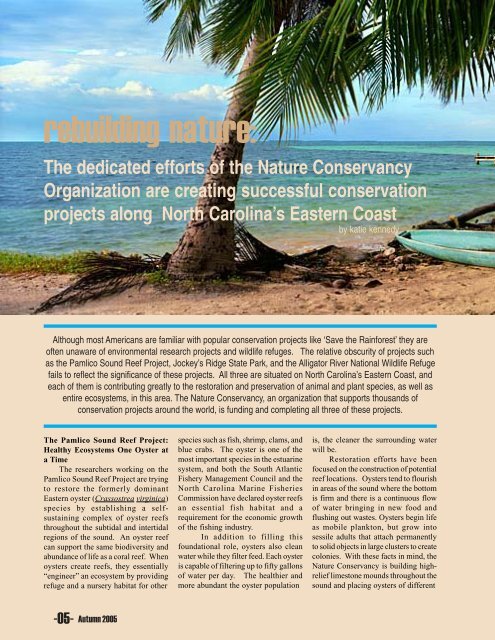Autumn 2005 Issue.pmd - Ohio State Engineer - The Ohio State ...
Autumn 2005 Issue.pmd - Ohio State Engineer - The Ohio State ...
Autumn 2005 Issue.pmd - Ohio State Engineer - The Ohio State ...
Create successful ePaper yourself
Turn your PDF publications into a flip-book with our unique Google optimized e-Paper software.
ebuilding nature:<br />
<strong>The</strong> dedicated efforts of the Nature Conservancy<br />
Organization are creating successful conservation<br />
projects along North Carolina’s Eastern Coast<br />
by katie kennedy<br />
Although most Americans are familiar with popular conservation projects like ‘Save the Rainforest’ they are<br />
often unaware of environmental research projects and wildlife refuges. <strong>The</strong> relative obscurity of projects such<br />
as the Pamlico Sound Reef Project, Jockey’s Ridge <strong>State</strong> Park, and the Alligator River National Wildlife Refuge<br />
fails to reflect the significance of these projects. All three are situated on North Carolina’s Eastern Coast, and<br />
each of them is contributing greatly to the restoration and preservation of animal and plant species, as well as<br />
entire ecosystems, in this area. <strong>The</strong> Nature Conservancy, an organization that supports thousands of<br />
conservation projects around the world, is funding and completing all three of these projects.<br />
<strong>The</strong> Pamlico Sound Reef Project:<br />
Healthy Ecosystems One Oyster at<br />
a Time<br />
<strong>The</strong> researchers working on the<br />
Pamlico Sound Reef Project are trying<br />
to restore the formerly dominant<br />
Eastern oyster (Crassostrea virginica)<br />
species by establishing a selfsustaining<br />
complex of oyster reefs<br />
throughout the subtidal and intertidal<br />
regions of the sound. An oyster reef<br />
can support the same biodiversity and<br />
abundance of life as a coral reef. When<br />
oysters create reefs, they essentially<br />
“engineer” an ecosystem by providing<br />
refuge and a nursery habitat for other<br />
species such as fish, shrimp, clams, and<br />
blue crabs. <strong>The</strong> oyster is one of the<br />
most important species in the estuarine<br />
system, and both the South Atlantic<br />
Fishery Management Council and the<br />
North Carolina Marine Fisheries<br />
Commission have declared oyster reefs<br />
an essential fish habitat and a<br />
requirement for the economic growth<br />
of the fishing industry.<br />
In addition to filling this<br />
foundational role, oysters also clean<br />
water while they filter feed. Each oyster<br />
is capable of filtering up to fifty gallons<br />
of water per day. <strong>The</strong> healthier and<br />
more abundant the oyster population<br />
is, the cleaner the surrounding water<br />
will be.<br />
Restoration efforts have been<br />
focused on the construction of potential<br />
reef locations. Oysters tend to flourish<br />
in areas of the sound where the bottom<br />
is firm and there is a continuous flow<br />
of water bringing in new food and<br />
flushing out wastes. Oysters begin life<br />
as mobile plankton, but grow into<br />
sessile adults that attach permanently<br />
to solid objects in large clusters to create<br />
colonies. With these facts in mind, the<br />
Nature Conservancy is building highrelief<br />
limestone mounds throughout the<br />
sound and placing oysters of different<br />
-05-<br />
<strong>Autumn</strong> <strong>2005</strong>



